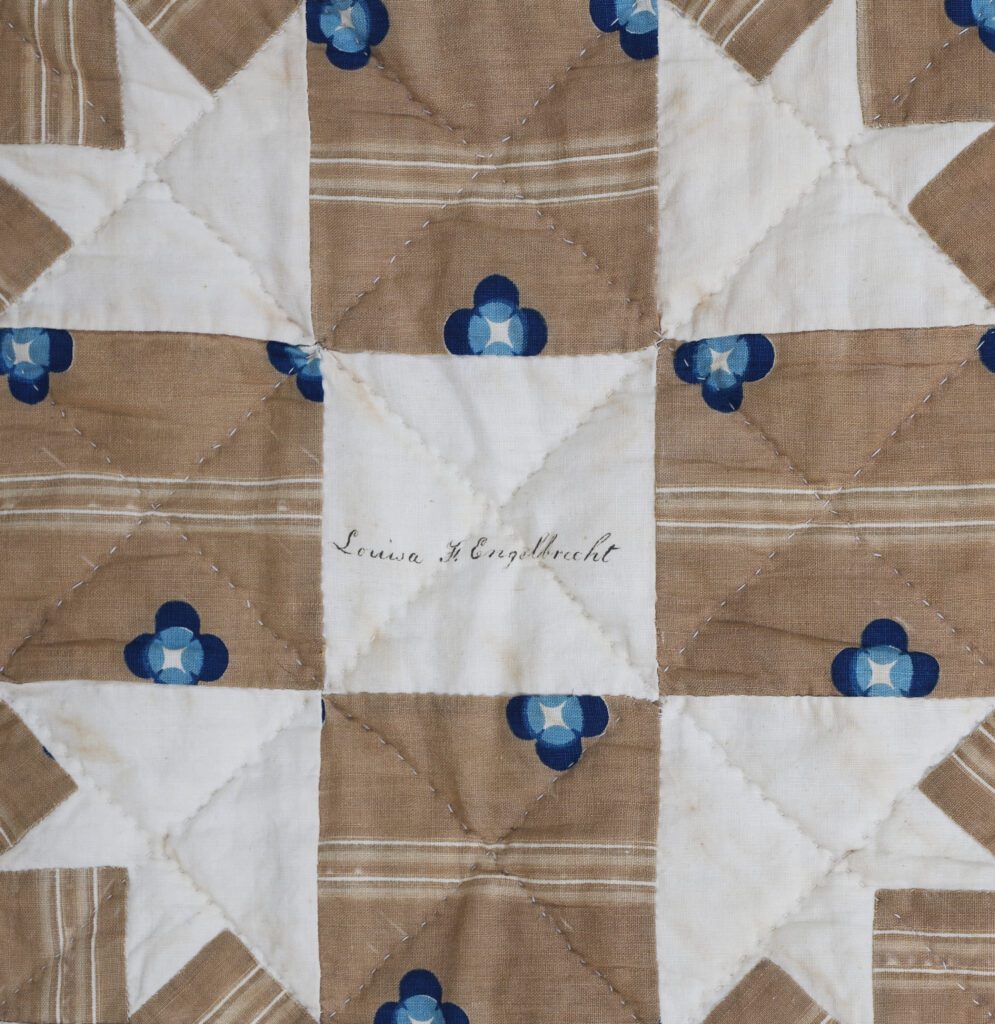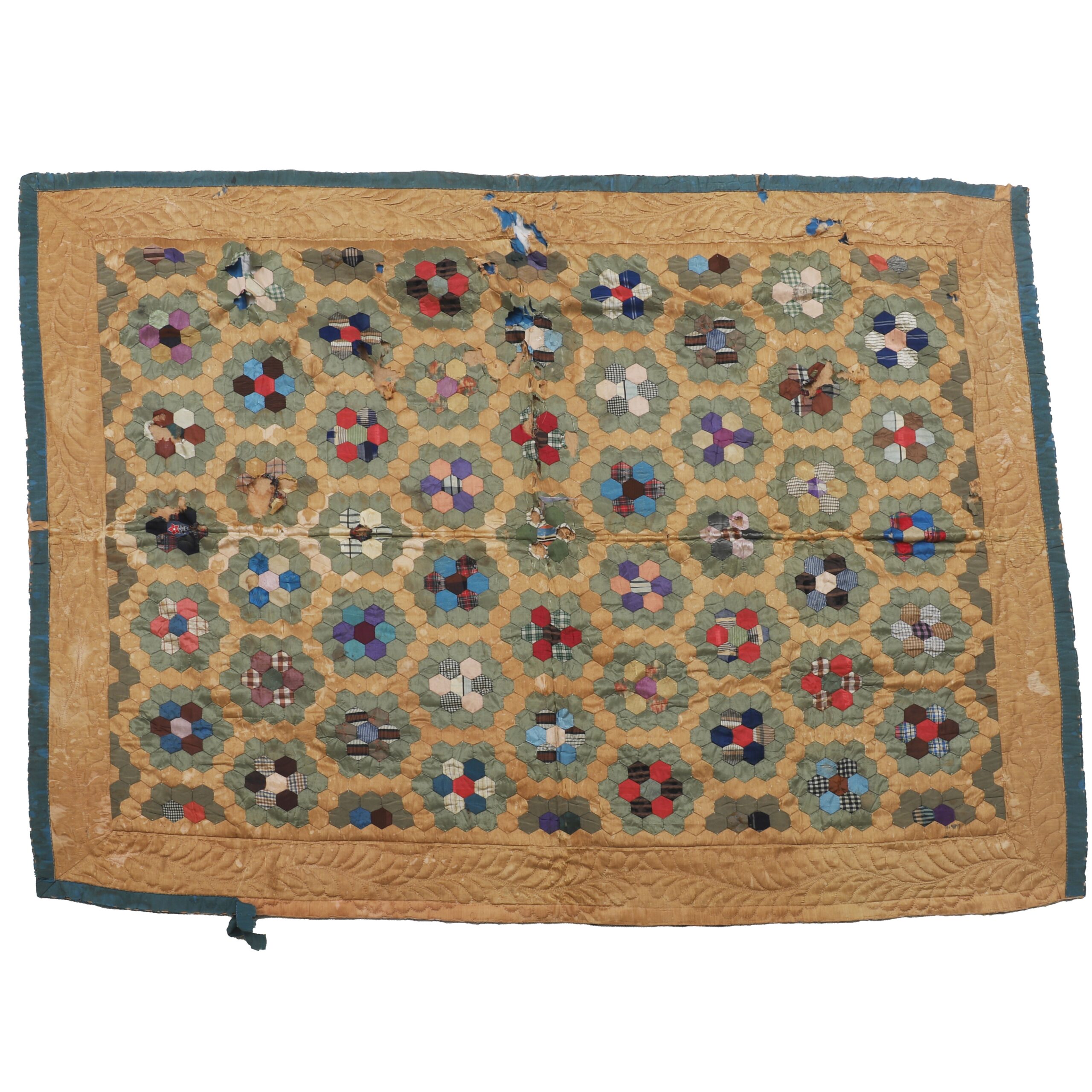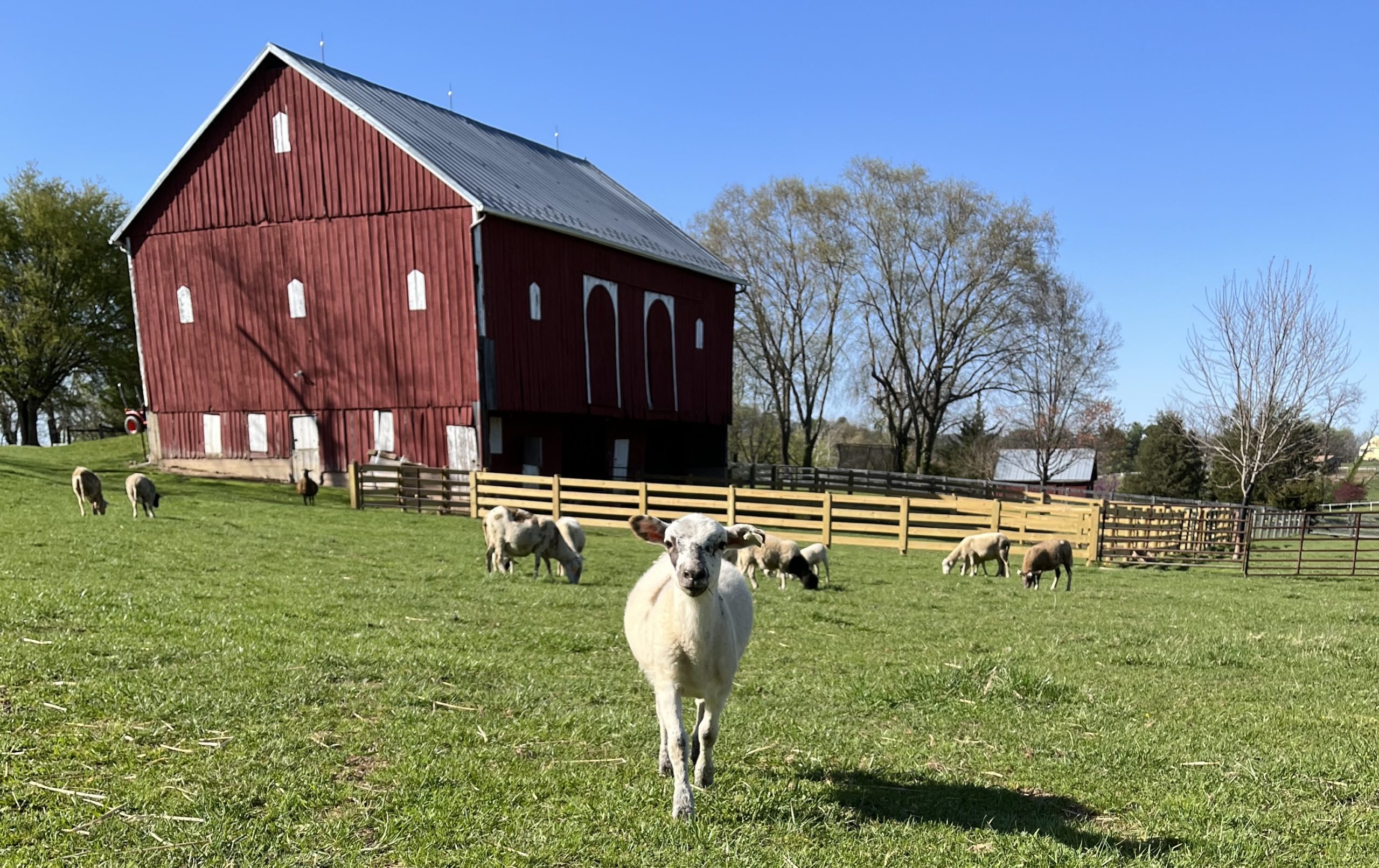
The first settlements in Maryland occurred in 1634 and concentrated in the coastal and inland-Bay regions. In the 18th century, English colonial leaders offered land grants to settlers at low prices meant to incentivize westward expansion. The land grants often were in 100- or 150-acre parcels, because a family lived off the land and needed ample space to harvest wood, plant crops and fruit trees, and raise livestock.
Farmsteads were isolated but self-sustaining. Frequently, a married couple had several children who became helpers on the farm at an early age. The typical gender segregation of duties had the father and sons outside, clearing land and tending to livestock and crops; the mother and daughters worked inside, preserving food and preparing meals, caring for young children, washing clothes, cleaning the house, and sewing garments and quilts that the family wore or used. Clothing and bedding typically served a utilitarian purpose that emphasized durability and function over style. Like their husbands in the fields, women were in charge of their work and themselves; the work of both was essential to the health and success of the family.

The equipment for producing wool textiles were commonplace in eighteenth and nineteenth century homes in Frederick County. These tools included (1) walking wheels, used for spinning wool fibers into yarn, and (2) winders onto which the spun yarn was coiled to measure its length.

In addition to textiles produced from wool, plant-based textiles were produced using flax. Once harvested from the field, production of flax linen required tools such as (3) hackles, a combing device used to straighten flax fibers and to clear them of impurities before they were spun using a (4) flax wheel to spin the small fibers into linen.
Hand-Sewing
Producing clothing, bedding, and other household textiles at home required raising sheep, shearing sheep, washing and then combing fleece before finally spinning it into yarn. Next, that yarn was woven into fabric that could be cut into patterns and sewn into finished goods. The process required considerable time and effort.
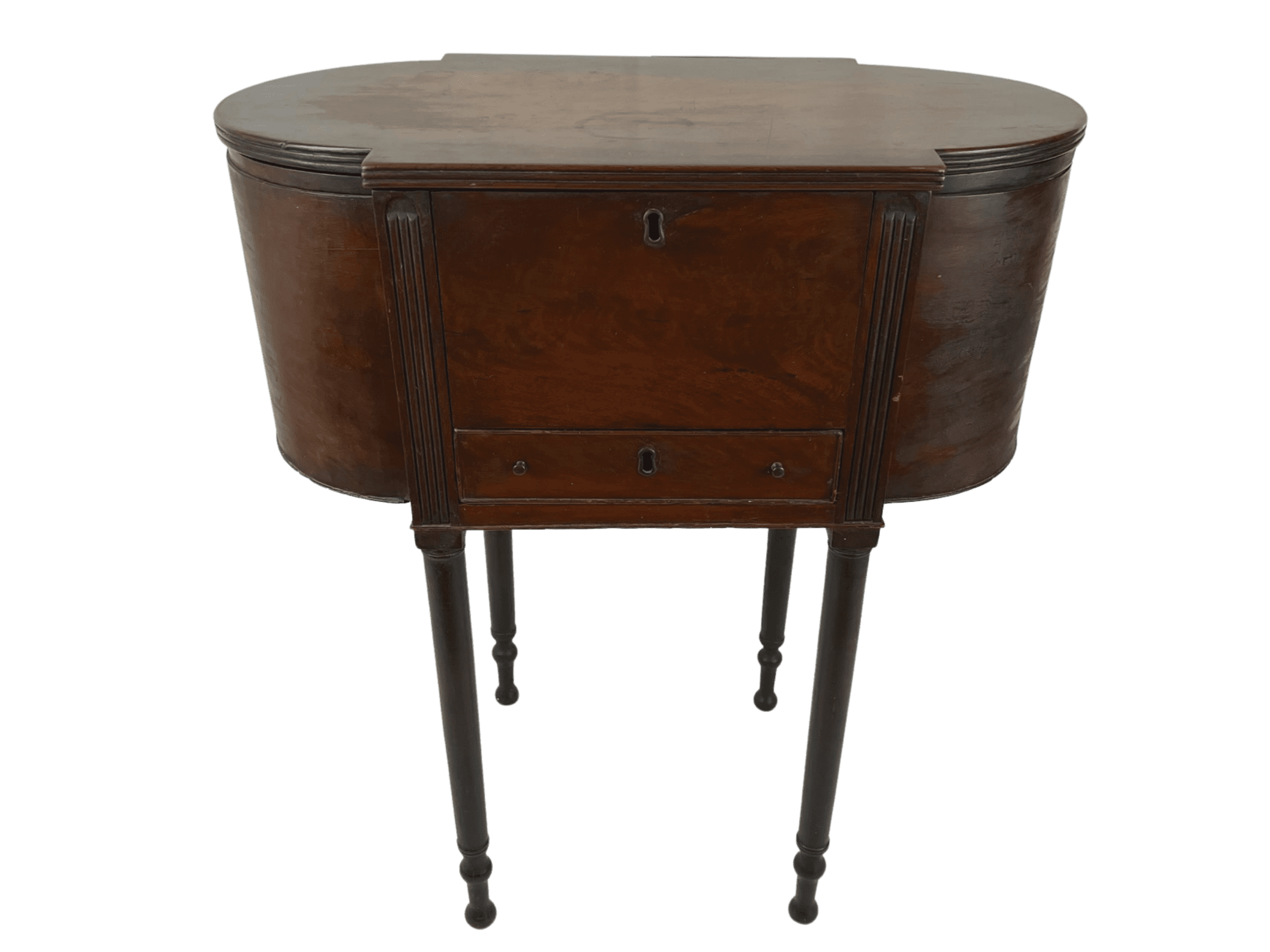
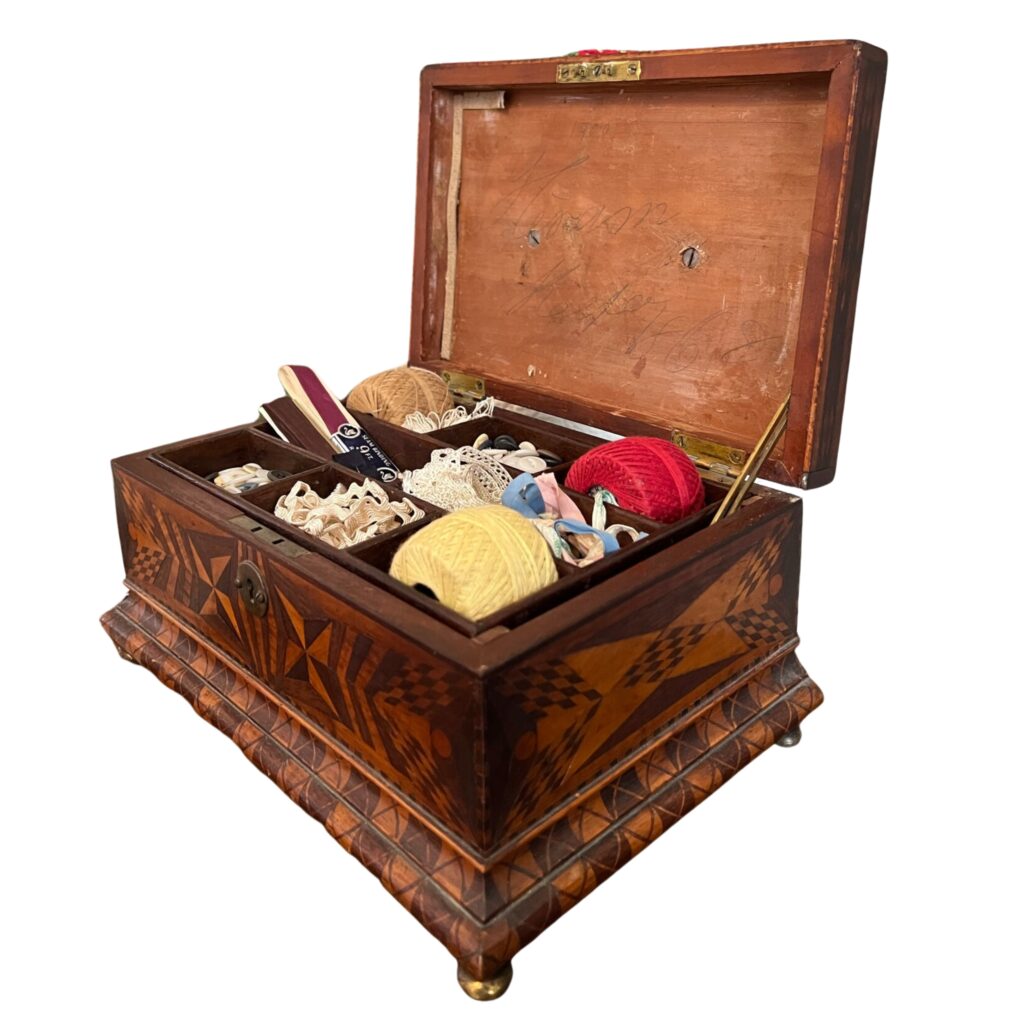
Neoclassical Sewing Table, wood, c. 1810, Owned by Catherine Worthington Johnson Ross, Frederick, Maryland. Gift of Charles W. Hoff, III
Marquetry Sewing Box, wood, c. 1900, Owned by Sophia Markell Detrick of Frederick, Maryland, Gift of Elizabeth R. Kemp Roszel

1) Hand-sewn, emerald green-plaid dress worn by Roseanna C. Fessler for her December 2, 1834 wedding to John Adams Simmons
2) Lady’s dress, two pieces, bodice and skirt, hand-sewn, black, silk taffeta, 1890-1900, Worn by Rose Marie Callahan Sappington of Libertytown, MD. Donated by Virginia Nicolaides in memory of Marie Rose Kelly Nicolaides.
3) Hand-sewn, cream wedding dress, 1875. Donated by Sarah Drenning
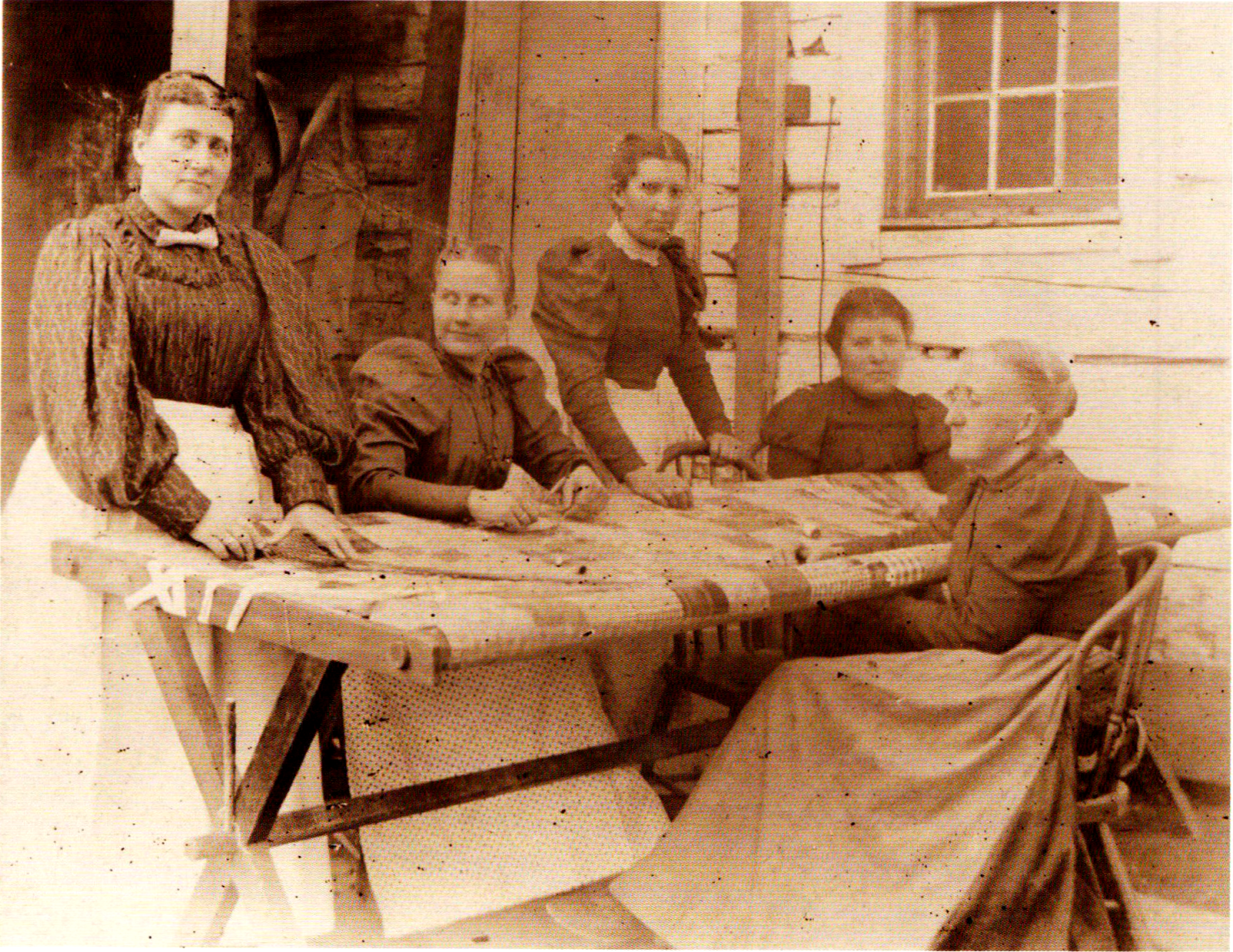
Hand-Sewn Quilts
Quilting is the process of sewing together layers of fabric and padding. Stitches pass through all of the layers creating a textile with additional warmth and durability, most often used for bedding. Quilts include a top layer of fabric, a filler or batting, and a backing. The American quilt-making tradition emerged in the late 1700’s and early 1800’s. Between the 1820’s and 1860’s, manufacturing and printing processes underwent significant improvements that ultimately made fabrics more affordable for average consumers, and the use of colors and patterns became more common. Quilters typically followed a variety of patterns – Bear Paw, Log Cabin, Irish Chain, Wedding Ring – and pattern selection, color choices, and intricate stitching allowed women to express their creativity.
Types of Historic Quilts

The earliest quilts in America commonly were called wholecloth quilts. The top fabric, typically cotton or wool, included several pieces of fabric sewn together. Because all the fabric was one color, usually white, it appeared to be one piece of cloth. The hand-stitchery served as the only decoration on the quilt. The most intricate stitching incorporated naturalistic forms, such as flowers and fruits. The use of double stitching around additional filling – commonly called trapunto – produced an impressive, more pronounced, three-dimensional design.
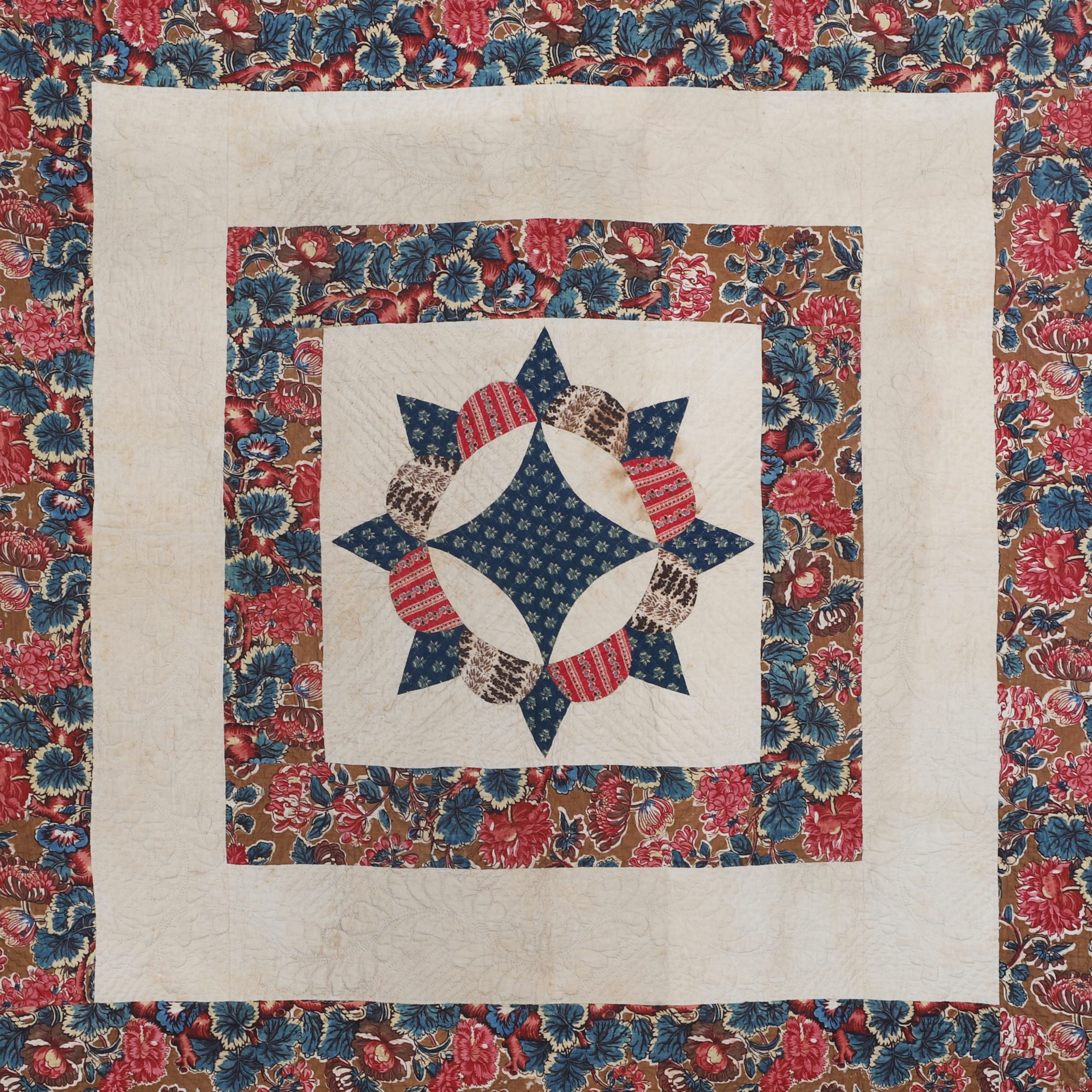
A medallion quilt involves a central motif or image as the focal point, surrounded by multiple borders. The center and borders can be appliqued or embroidered.

An album or signature quilt is made by several people, each sewing their own square using a single or multiple designs that are stitched together to form one large quilt. Each block represented a message from the woman who made it for the person who would receive the quilt. This type of quilt usually became a wedding or going-away gift.

A patchwork or piece quilt is one where the quilt top is made by joining small patches or shapes of different colored and patterned fabrics together to form a whole.
Quilts Featured in Stitches Through Time

Album Quilt, cotton, c. 1848, Made in Woodsboro, Maryland by friends of Mary Ann Hyder and presented to her on the occasion of her marriage to William Henry Bowman, 8 March 1848, Gift of Mary Catherine Muse Ortega.
Mary Ann Hyder was born in Woodsboro in 1828, the seventh of thirteen children for Jacob W. Hyder, a farmer, and his wife, Sarah Lightner Hyder. On March 8, 1848 Mary Ann married William Henry Bowman, a merchant tailor from Johnsville; Mary Ann’s friends lovingly made this album quilt as a wedding gift. Mary Ann and her husband remained in the Woodsboro area. They had eight children, six of whom lived into adulthood. This treasured wedding quilt was passed lovingly to a daughter of each generation until coming to rest with Mary Ann Hyder’s great-great granddaughter, Mary Catherine Muse Ortega of Pueblo, Colorado, who donated the quilt to Heritage Frederick in 2014.
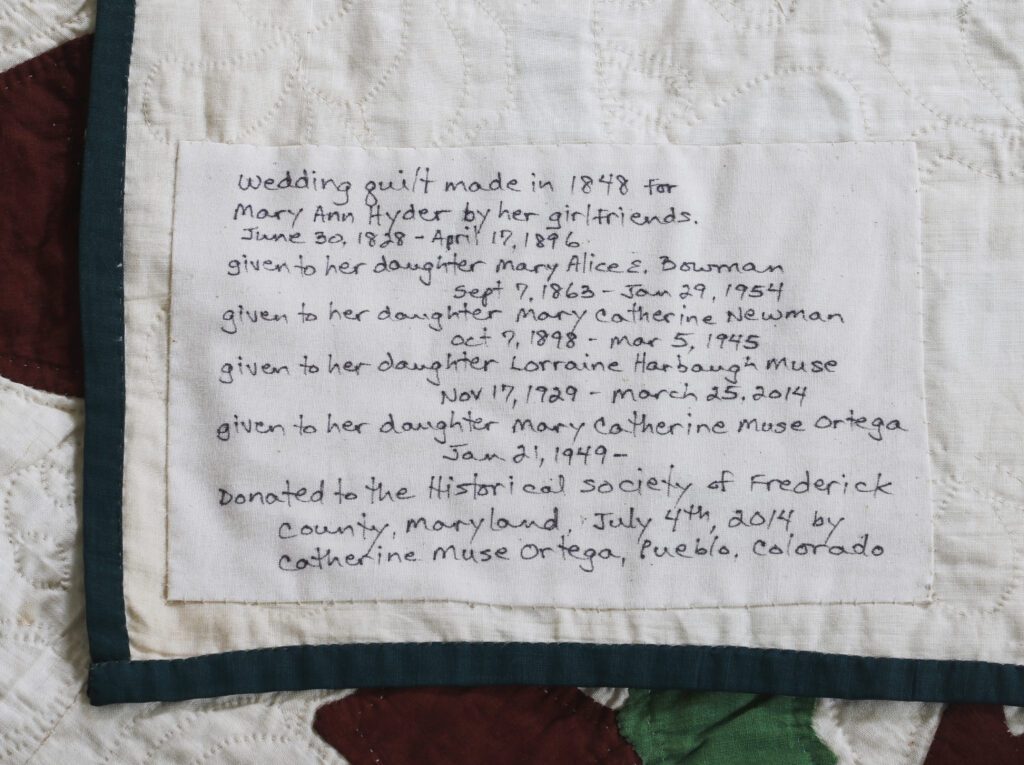
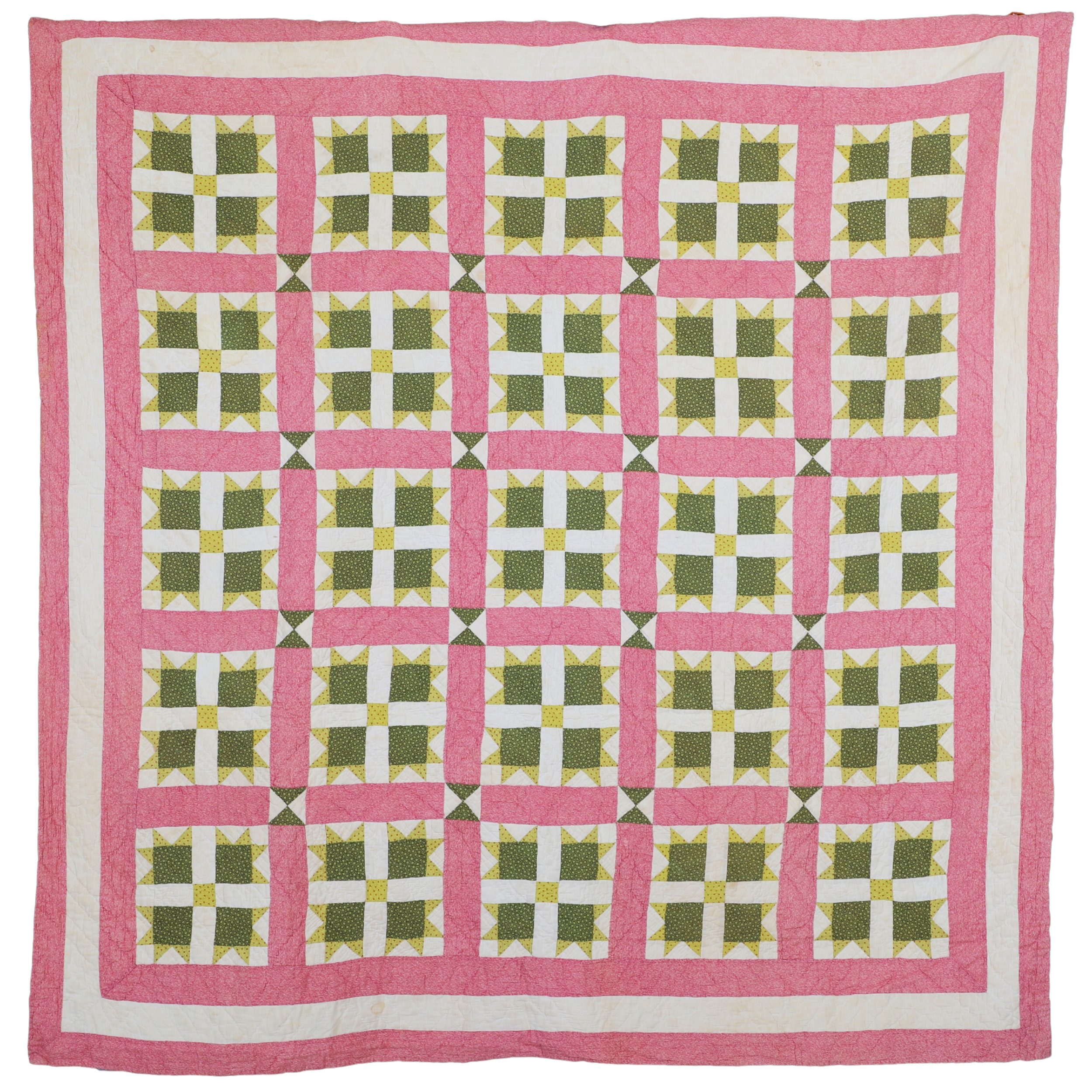
Pieced Patchwork Quilt, Turkey Tracks or Bear Paw Pattern, cotton, c. 1870. Most likely made by Georgianna Victoria Clem Rice, Creagerstown, MD. Used in the household of Marion Davis and R. Pauline Yinger Boyer at 351 West Patrick Street, Frederick, MD. Donated by Linda B. Brundrett.
This hand-stitched, Turkey Tracks or Bear Paw pattern quilt, while beautiful and expertly assembled, would have been meant for use rather than for display. The quilting is much more functional, serving the purpose of anchoring the various layers of material together and is not rendering into swirling or fanciful patterns that only a close and patient eye could observe. Dated to the 1870s, the quilt most likely was made by Georgianna Victoria Clem Rice during her early married life.
Georgianna was born in Creagerstown in 1842, the oldest of six children by George Alexander Clem, a blacksmith, and his wife Eliza Devilbiss Clem. In 1870, Georgianna married Isaiah Washington Rice, a farm laborer and cooper. Isaiah’s mother died when he was just three years old, leaving three sons under the age of 5. His father, George C. Rice, married a second time and had two more children but then also passed away very young, at the age of 37 when Isaiah was just 13. The 1860 census shows the Rice children scattered across the Midwest.
With the outbreak of the Civil War, Isaiah enlisted as a Union private in the 93rd Illinois Infantry, Company K. He received an honorable discharge in August of 1863 because of a broken arm, but Isaiah recovered and enlisted again a month later, this time in Shelbyville, TN, and served as a private with the 5th Cavalry, Company E until November 1865. Following the war, he returned to Maryland where he met and married Georgianna. Isaiah and Georgianna Rice lived in Woodsboro. Their five children were born during the first 10 years of their marriage, and she most likely created the quilt in that span of years, too. Georgianna’s great-granddaughter, Linda Boyer Brundrett, donated the quilt to Heritage Frederick in 2010.
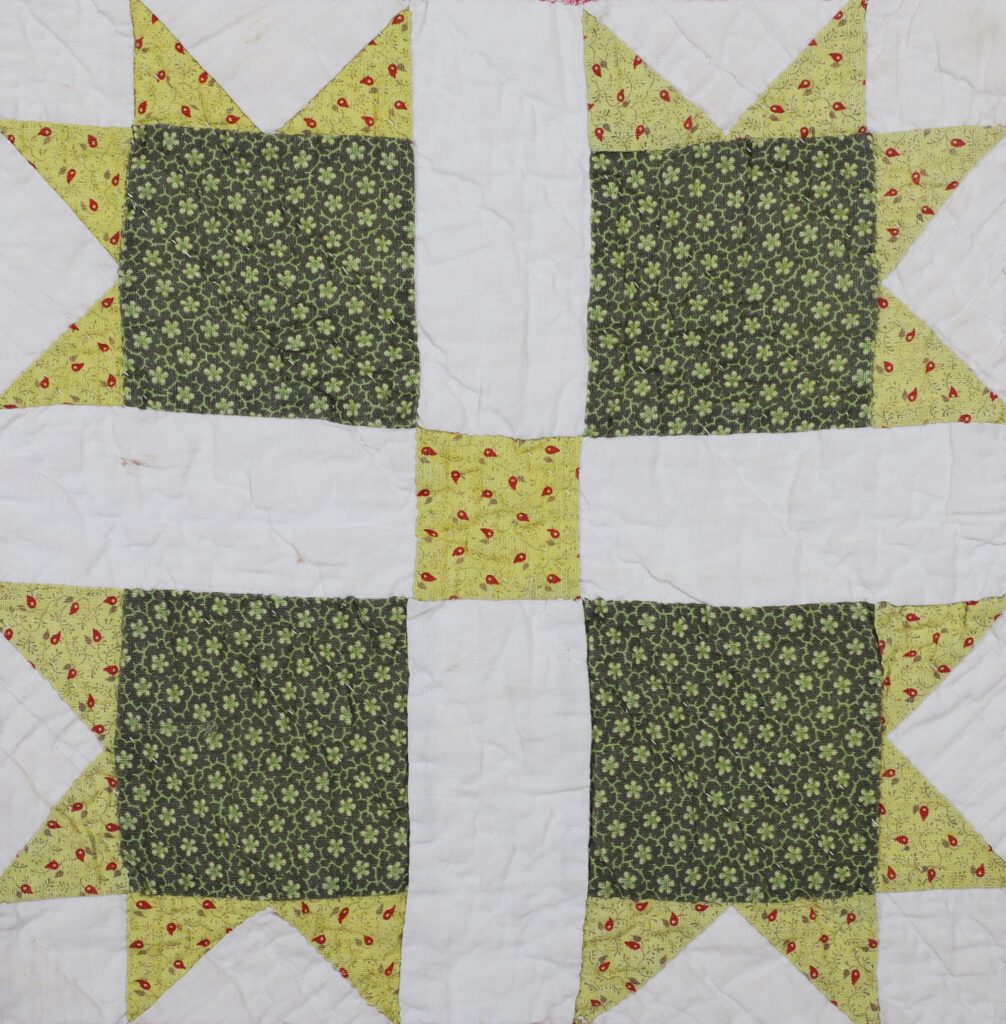
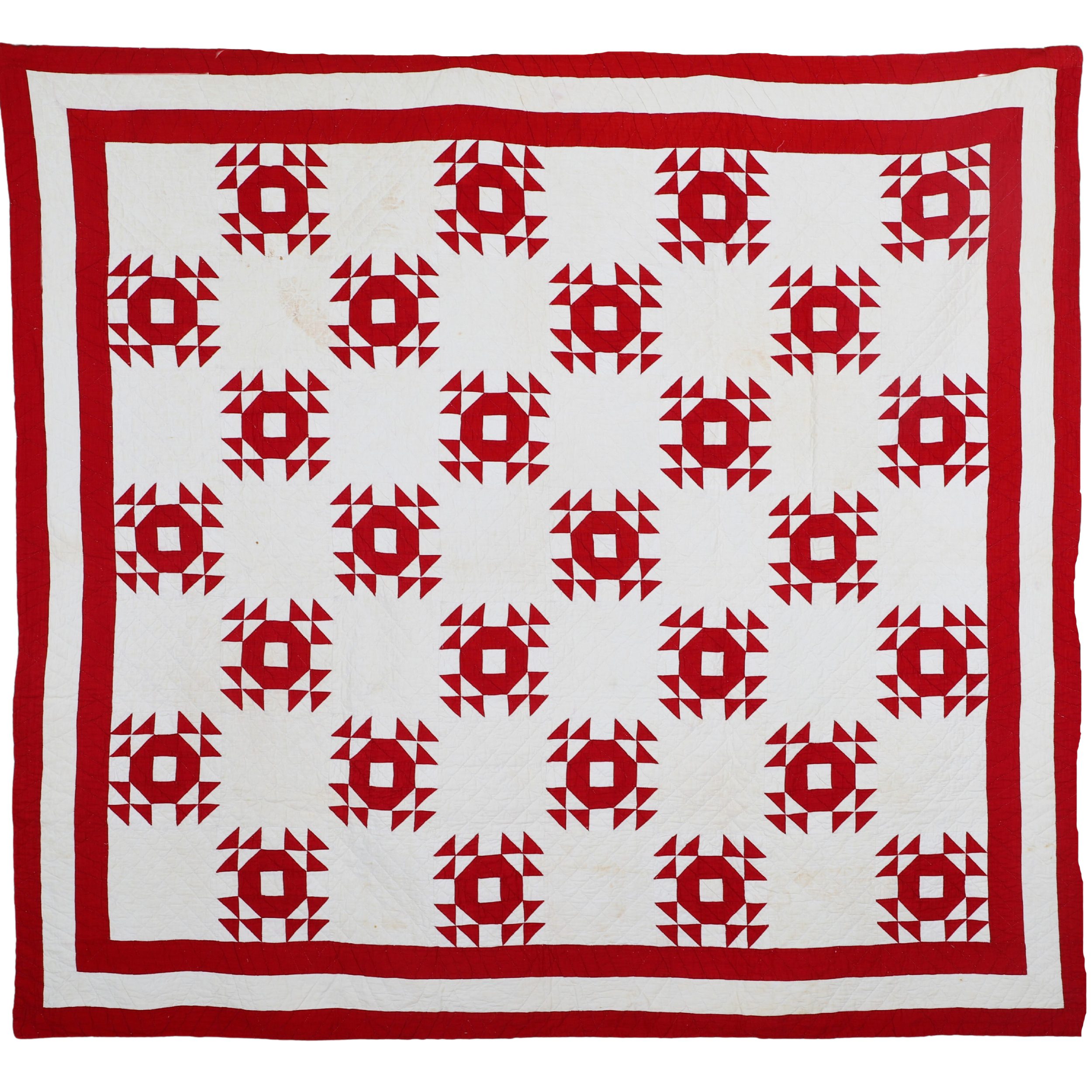
Pieced Patchwork Quilt, Wedding Ring Pattern, cotton, c. 1880. Most likely made by Georgianna Victoria Clem Rice, Creagerstown, MD. Used in the household of Marion Davis and R. Pauline Yinger Boyer at 351 West Patrick Street, Frederick, MD. Donated by Linda B. Brundrett.
This quilt, like the Turkey Tracks or Bear Paw pattern quilt also featured in our exhibit, likely was made by Georgianna Victoria Clem Rice. The red and white pattern, called wedding ring, now appears unusual to those familiar with the highly popular double wedding ring pattern of the 20th century.

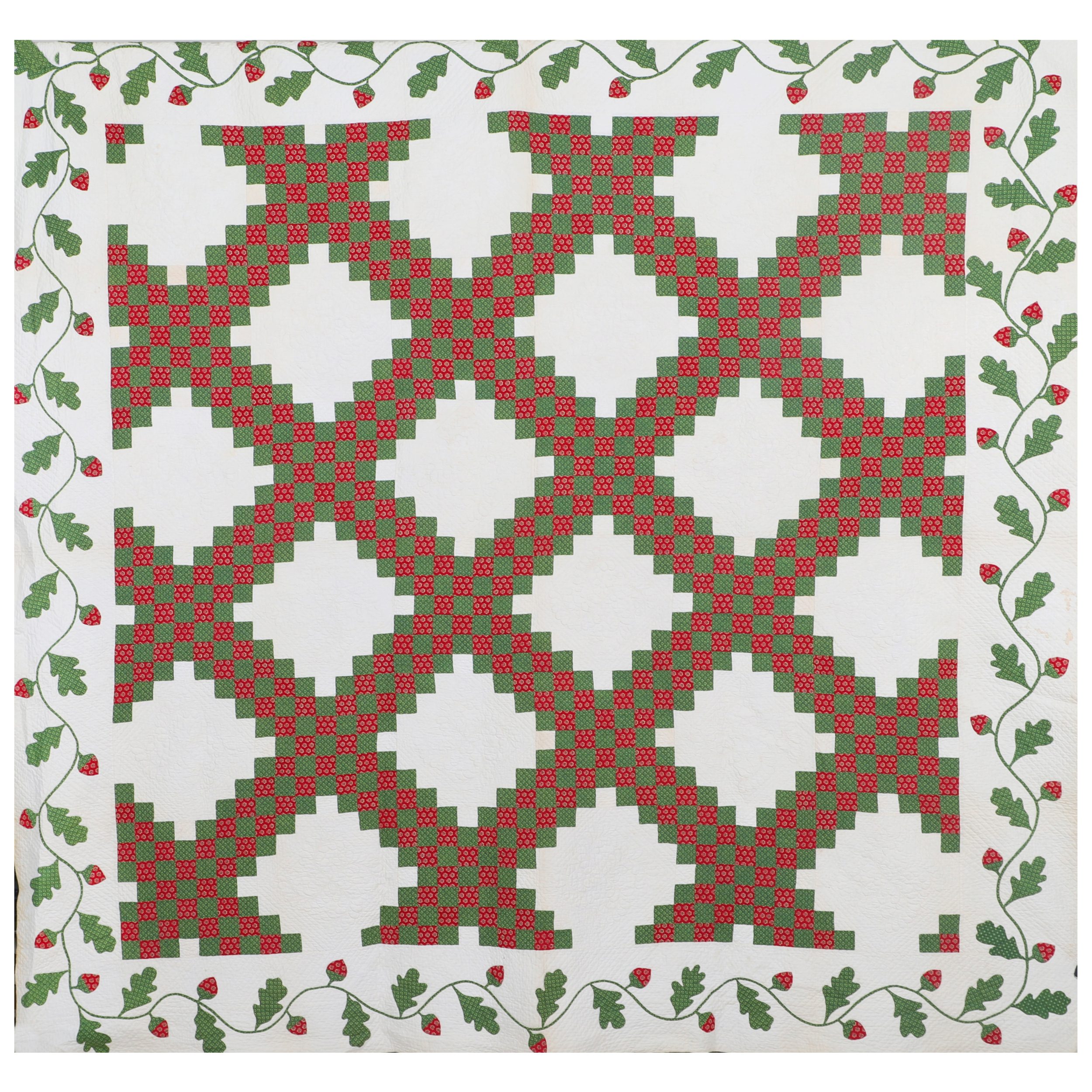
Pieced Patchwork Quilt, Triple Irish Chain Pattern with applique Oak Leaf and Acorn Border, cotton,1858. Made by Ann Gore Kinzer of Johnsville, MD and given to Eliza Pharis. Donated by Katherine S. Hazen.
Eliza Ann Webb was born in 1834 in Cazenovia, NY, located about 20 miles southeast of Syracuse. She was the oldest child of master carpenter and joiner, David Baldwin Webb, and his wife, Elvira Gage Webb. In 1857, at the age of 23, Eliza moved to Frederick County and got a job teaching at the seminary in Liberty (now Libertytown). The following year Eliza started teaching the youngest children of John and Ann Gore Kinzer of Johnsville. John Kinzer was a local merchant and during the time that Eliza spent in their home, Ann was engaged in making this intricately patterned, red and green quilt. With political tensions escalating across the nation in advance of the 1860 election, Eliza made the decision to return home to New York. Once back home Eliza decided to try to replicate the quilt she had seen Ann Kinzer making and started her own red and green quilt.
At the end of the 1860s, Eliza became the second wife of Mills P. Pharis, a salt manufacturer from Geddes, NY whose first wife died following the birth of their third son. Eliza and Mills had one child, a daughter, Mary Pharis, born in 1871. At some point after Eliza finished her duplicate quilt, Ann Kinzer sent her own, original finished work to Eliza as a gift. Ann’s quilt and its replica were passed down together through the family to Eliza’s granddaughter, Katherine Salisbury Hazen who donated the Johnsville gift to Heritage Frederick in 1973.
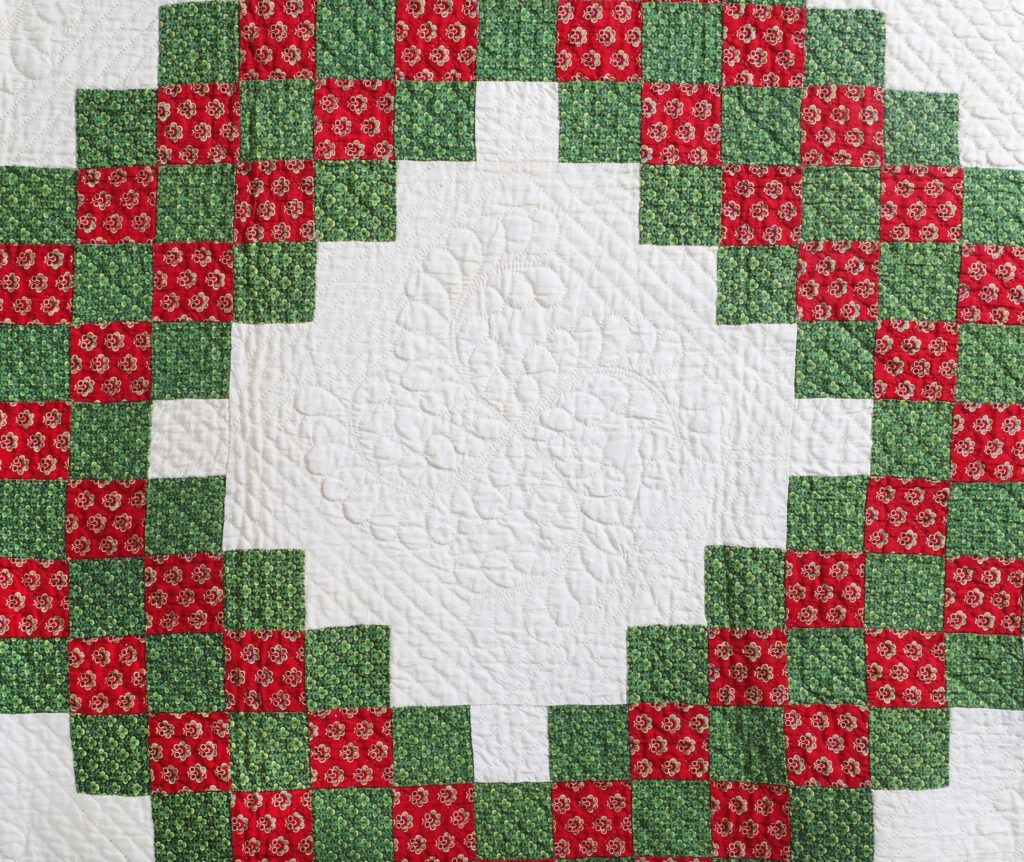
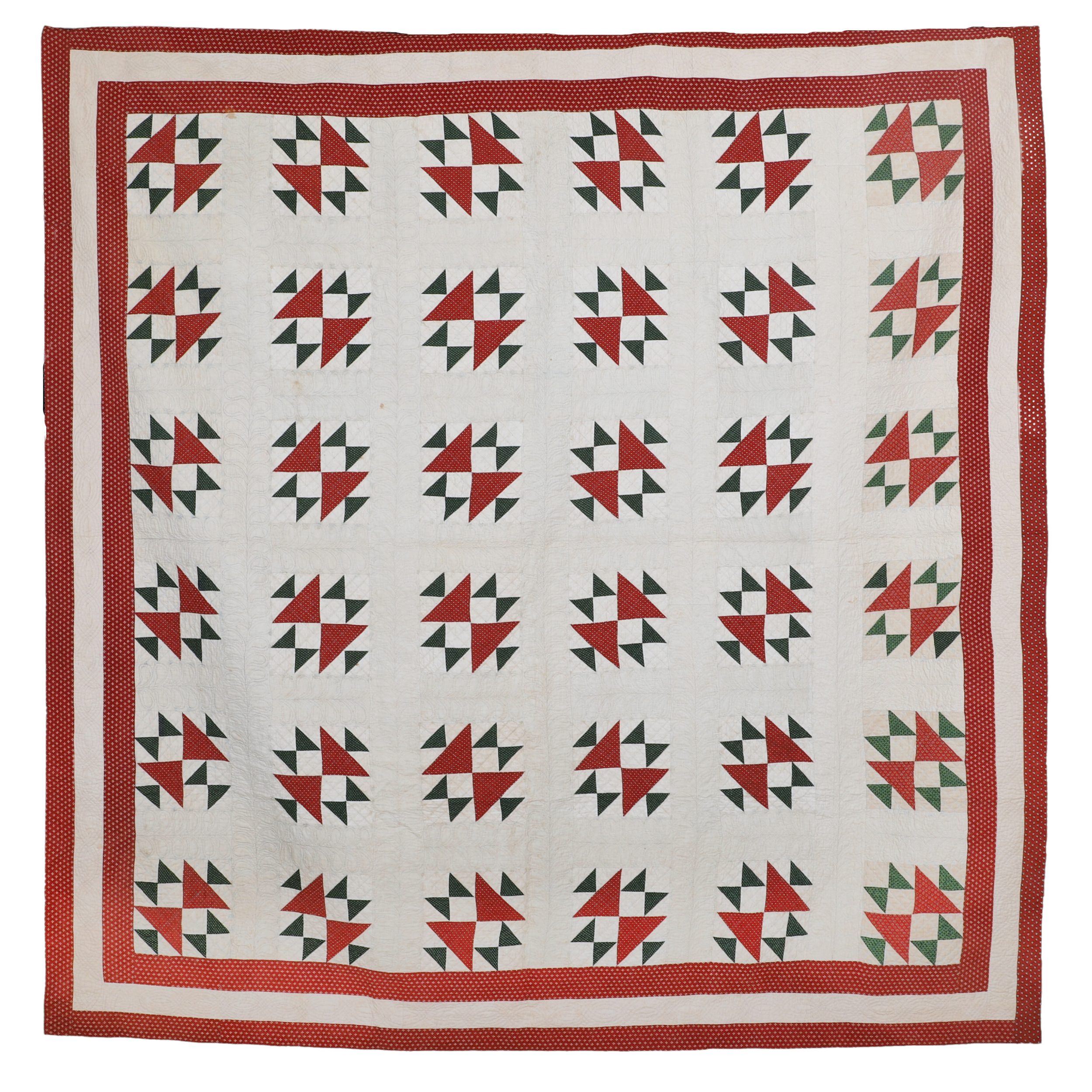
Pieced Patchwork Quilt, Double “X” Pattern, cotton, 1850. Donated by the family of Richard Summers.

Medallion Crib Quilt, cotton
Tiger Maple Cradle, wood
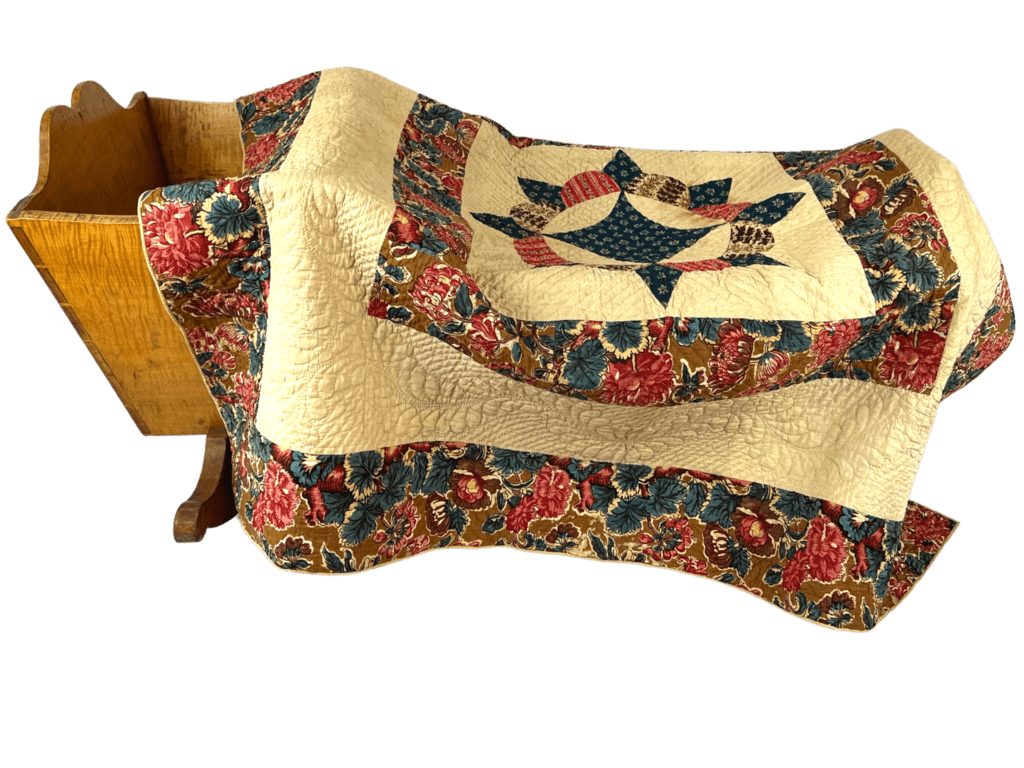
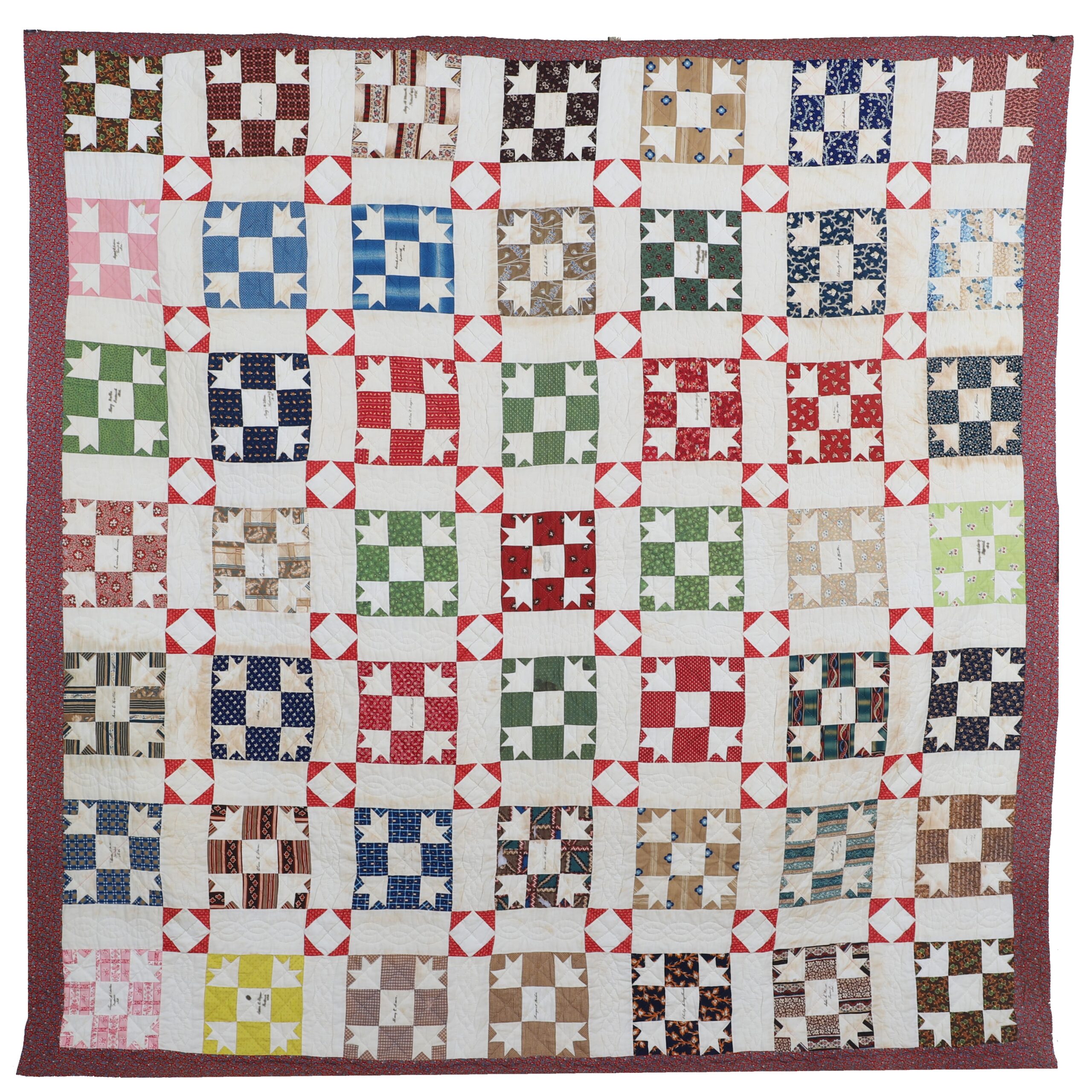
Pieced Patchwork Signature Quilt, Bear Paw Pattern, c. 1850, Engelbrecht Family, Frederick City, Donated by Mr. and Mrs. William Rhoads
